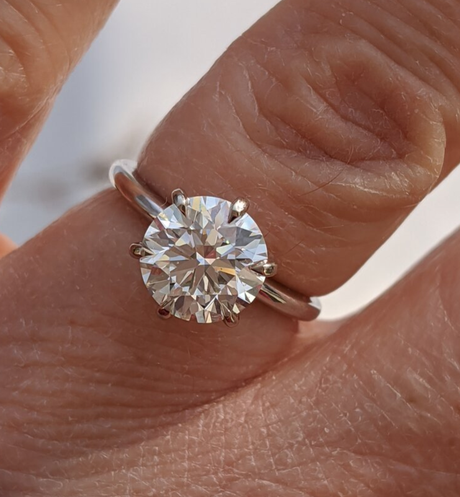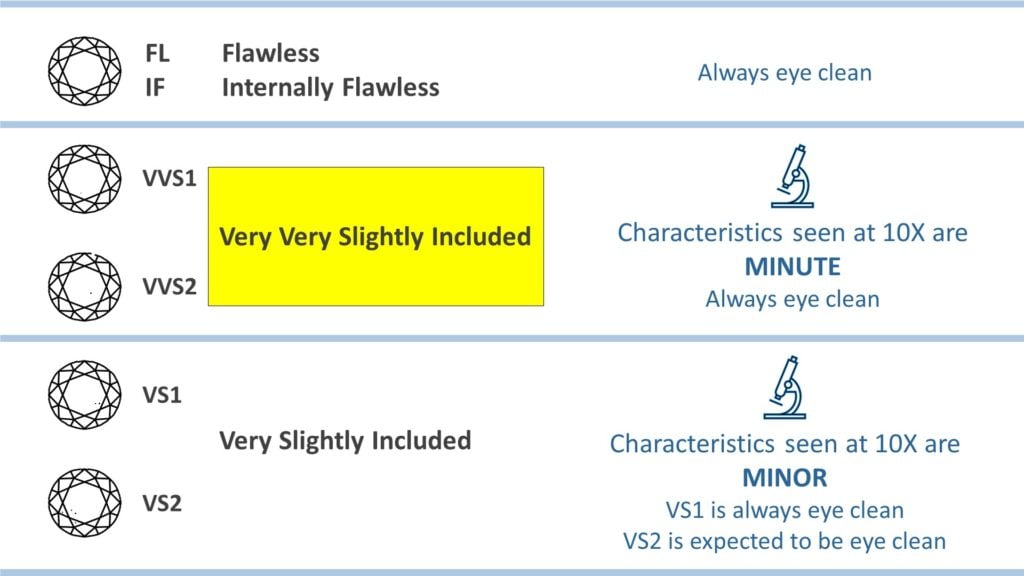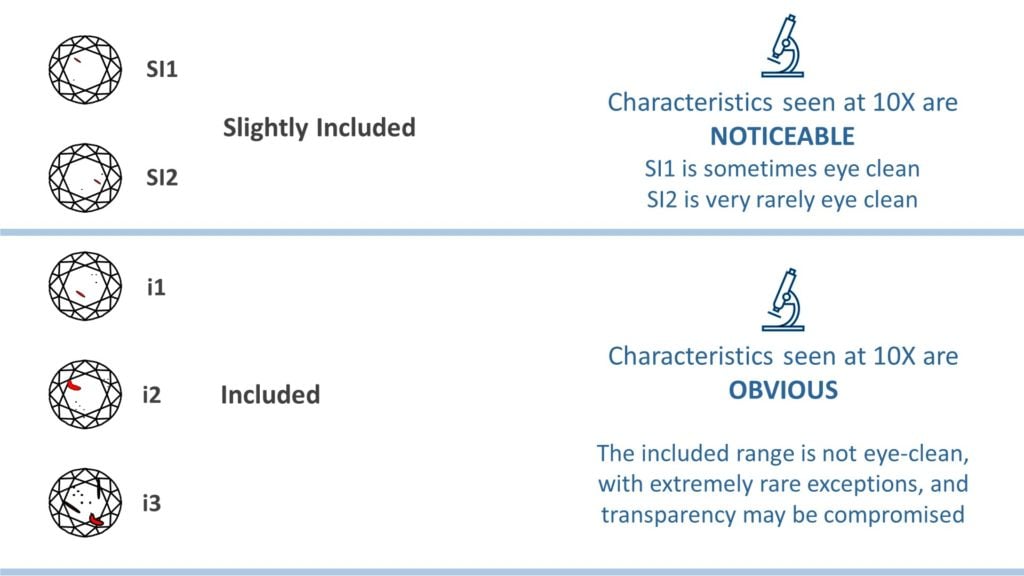VVS Diamond Clarity – Basics
VVS diamonds land in the rare collection category when paired with D, E or F color and a top cut grade. Here is useful information when considering a diamond in the VVS range.
PriceScope Pointer: Unless you have a specific reason to spend for VVS diamond clarity you will get identical clarity appearance at VS1 clarity, most often with VS2 clarity and sometimes even with SI clarity.
Before going on: Check out the PriceScope Diamond Buying Guide
VVS Diamond Clarity Described
The diamond clarity grade describes a stone’s relative freedom from internal characteristics, classified as inclusions, and surface characteristics, classified as blemishes.
VVS diamond clarity describes gems with inclusions considered minute by a gemologist when using 10X magnification. Put another way, the inclusions in VVS diamonds are very to extremely difficult for a professional to find, even with magnification. The VVS diamond clarity range spans two levels. A VVS1 diamond has less noticeable clarity characteristics than a VVS2 diamond.
The most typical VVS inclusion is the pinpoint. Reflective internal graining, minor bruises or tiny chips could establish VVS1 or VVS2 clarity, depending on specifics.
Wondering which of the many diamond colors is best for you? Our elite list of vetted vendors like Whiteflash and James Allen are experts at listening and helping you determine which combo of the 4Cs is perfect for you - and nicely in budget. Contact Us and get help today.
VVS Diamonds: Let’s Get Practical
Are VVS diamonds always eye-clean?
Yes. Any VVS diamond will be absolutely eye clean by the definition below. VVS1 is as close as a diamond to get to being considered Internally Flawless. The inclusions in a VVS1 diamond may not even be visible in the face up position, even with a microscope. In certain cases, they are located using 10X magnification while viewing the diamond through the pavilion. The inclusions in a VVS2 diamond are difficult to see in the face up position, even with a microscope.
There is no laboratory definition for eye-clean, but a PriceScope survey of gemologists resulted in this consensus:
 Photo Courtesy of PS member Soxfan
Photo Courtesy of PS member Soxfan
Eye-clean = No inclusions visible to the unaided eye when viewed from the face up position in daylight equivalent or fluorescent lighting from approximately 6 – 12 inches from the eye using 20/20 vision.
VVS Diamonds: Real World Information
A VVS diamond will not sparkle better than a diamond with lower clarity. A diamond’s observable brightness, fire, sparkle, and contrast are all attributable to its cut quality. A diamond’s optical properties are not influenced by inclusions and blemishes, except in the very lowest grading category Included: (I1-I2-I3): Those three grades are reserved specifically for diamonds with inclusions numerous or severe enough to impact light transmission and/or durability.
All VVS diamonds, when paired with D,E, or F color and a top cut grade, are considered to be collection quality. Such diamonds, with the purest natural color and clarity grades, have typically held their value best over time and have a special status in the eyes of many diamond professionals, collectors, enthusiasts, and auction houses.
PriceScope’s 1-5 star ratings are categorical comparisons with the most thorough, consumer-focused online diamond and jewelry vendors, in categories, we believe reflect our experienced consumer community’s values. Check out PriceScope Jeweler Reviews.
Intermediate VVS Diamond Clarity
Where do VVS diamonds rank?
The internationally accepted grading scale and terminology for diamond clarity consist of 11 grading levels. Grading is traditionally performed using 10 power (10X) magnification. A VVS diamond falls into the “slightly included” range, atop the bottom five grades.


A clarity grader will also consider the location, number, color, size, and nature of the characteristics present at 10x magnification when deciding the clarity grade.
If you’re looking to buy loose diamonds online, use our special tools to reveal the best cut quality diamonds! Start your diamond search and choose from over a million loose diamonds for sale. Use our filters to find either natural or lab diamonds, as well as fancy color diamonds.
Standards, Subjectivity, and Value
While the descriptive scale above is universally applied, standards can vary between individuals and organizations that decide VVS diamond clarity.
Subjectivity
Variance between reputable graders and organizations may be attributable to standard deviation. Color and clarity judgments are matters of opinion and diamonds often sit on the border of two grades. The only time this becomes an issue is when a buyer and seller disagree about which set of grades establish the diamond’s value.
Value and Over Grading
Intentional over grading has been a historic issue in the diamond trade. Over grading is a willingness to purposely deviate from internationally accepted standards to inflate the perceived value of a diamond. Certain locations of the EGL (now closed) became infamous for over-grading loose diamonds, by 3-4 grades in some cases, permitting unscrupulous sellers to overcharge consumers.
Value and Under Grading
Under grading occurs when a jeweler examines a diamond and claims it was over graded to create fear-based doubts in the diamond owner’s mind. The most frequent example of under grading is when one jeweler implies a consumer overpaid a competing jeweler, hoping the consumer will return the diamond and purchase there, instead.
Get quick answers to any question now: Ask our community of unbiased independent helpers.
